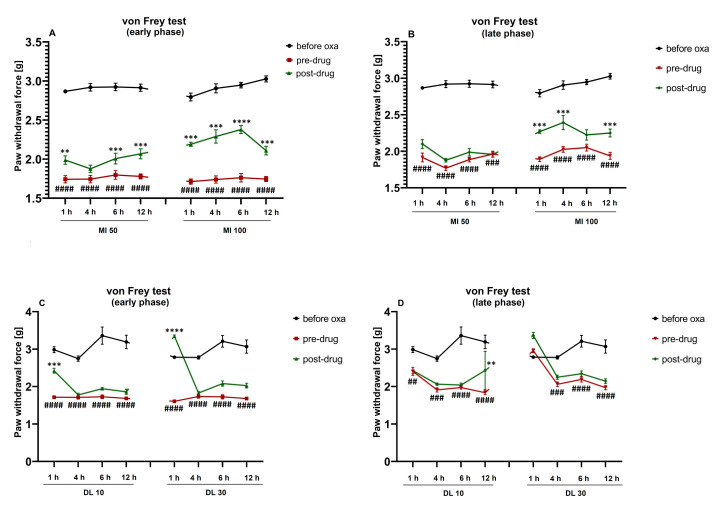Figure 4.
Duration of the antiallodynic effect of single-dose minocycline and duloxetine, each used alone, on the pain threshold in oxaliplatin-treated mice. Effect of minocycline (50, 100 mg/kg, i.p.) on tactile allodynia measured in the von Frey test assessed 1 h, 4 h, 6 h and 12 h after administration, on the day of oxaliplatin administration (A) and 7 days after oxaliplatin (B). Effect of duloxetine (10, 30 mg/kg, i.p.) on tactile allodynia measured in the von Frey test assessed 1 h, 4 h, 6 h and 12 h after administration, on the day of oxaliplatin administration (C) and 7 days after oxaliplatin (D). The results are shown as the mean paw withdrawal threshold ± SEM for n = 10. Statistical analysis: repeated measures ANOVA followed by Tukey’s post-hoc comparison. Significance: ## p < 0.01, ### p < 0.001, #### p < 0.0001 vs. before oxaliplatin; ** p < 0.01, *** p < 0.001, **** p < 0.0001 vs. pre-drug paw withdrawal threshold. Abbreviations: MI—minocycline, DL—duloxetine. In the figure titles ‘early phase’ (A,C) and ‘late phase’ (B,D) mean two time points at which the measurements were taken (day of oxaliplatin administration and day 7 after a single-dose oxaliplatin administration, respectively). Numerical values of the paw withdrawal thresholds ± SEM presented in this figure are shown in the Supplementary Materials (Table S2).

